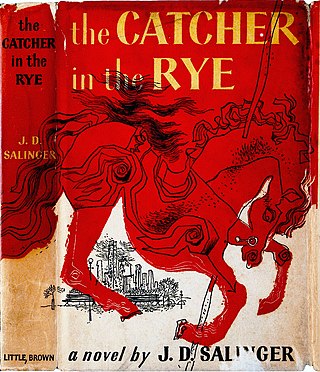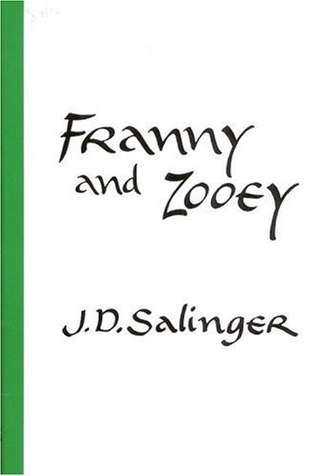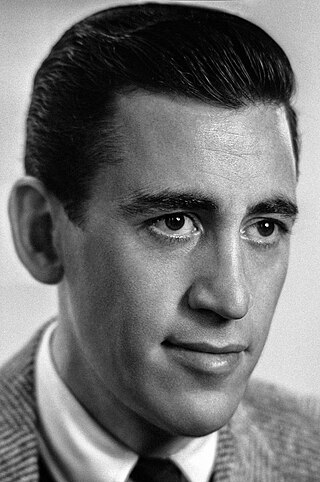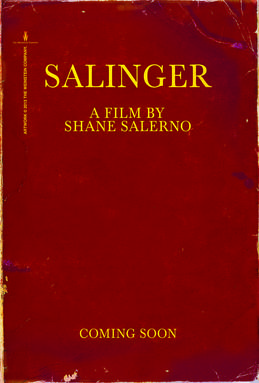Related Research Articles

The Catcher in the Rye is a novel by American author J. D. Salinger that was partially published in serial form in 1945–46 before being novelized in 1951. Originally intended for adults, it is often read by adolescents for its themes of angst and alienation, and as a critique of superficiality in society. The novel also deals with themes of innocence, identity, belonging, loss, connection, sex, and depression. The main character, Holden Caulfield, has become an icon for teenage rebellion. Caulfield, nearly of age, gives his opinion on a wide variety of topics as he narrates his recent life events.

Holden Caulfield is a fictional character in the works of author J. D. Salinger. He is most famous for his appearance as the lead character and narrator of the 1951 novel The Catcher in the Rye. Since the book's publication, Holden has become an icon for teenage rebellion and angst, and is considered among the most important characters of 20th-century American literature. The name Holden Caulfield was initially used in an unpublished short story written in 1941 and first appeared in print in 1945.
"A Perfect Day for Bananafish" is a short story by J. D. Salinger, originally published in the January 31, 1948, issue of The New Yorker. It was anthologized in 1949's 55 Short Stories from the New Yorker, as well as in Salinger's 1953 collection Nine Stories. The story is an enigmatic examination of a young married couple, Muriel and Seymour Glass, on vacation in Florida. It is the first of his stories to feature a member of the fictional Glass family.

Franny and Zooey is a book by American author J. D. Salinger which comprises his short story "Franny" and novella Zooey. The two works were published together as a book in 1961, having originally appeared in The New Yorker in 1955 and 1957 respectively. The book focuses on siblings Franny and Zooey, the two youngest members of the Glass family, which was a frequent focus of Salinger's writings.

"For Esmé—with Love and Squalor" is a short story by J. D. Salinger. It recounts an American sergeant's meeting with a young girl before being sent into combat in World War II. Originally published in The New Yorker on April 8, 1950, it was anthologized in Salinger's Nine Stories two years later.
Laughing Man may refer to:
"De Daumier-Smith's Blue Period" is a short story by J. D. Salinger, first published in the May 1952 edition of World Review (London). Declined by The New Yorker on November 14, 1951, as the piece was judged too short to adequately address the complex religious concepts that Salinger attempted to convey. It is known that Salinger struggled with writing it for over five months in 1951. While the New Yorker initially declined this story, Salinger still managed to publish Pretty Mouth and Green My Eyes in the July 1951 edition of The New Yorker.
"Uncle Wiggily in Connecticut" is a short story by J. D. Salinger, which appears in his collection Nine Stories. It was originally published in the March 20, 1948 issue of The New Yorker.
"Pretty Mouth and Green My Eyes" is a short story by J.D. Salinger, initially published in the July 14, 1951 issue of The New Yorker, and later within the larger collection of Salinger's short works, Nine Stories. Over the span of a few telephone conversations, the story surrounds three adult characters and the remainder of their evening after leaving a party.
"Down at the Dinghy" is a short story by J. D. Salinger, originally published in Harper's in April 1949, and included in the compilation, Nine Stories.

Shoeless Joe is a 1982 magic realist novel by Canadian author W. P. Kinsella that was later adapted into the 1989 film Field of Dreams, which was nominated for three Academy Awards.
The 1951 novel The Catcher in the Rye by J. D. Salinger has had a lasting influence as it remains both a bestseller and a frequently challenged book. Numerous works in popular culture have referenced the novel. Factors contributing to the novel's mystique and impact include its portrayal of protagonist Holden Caulfield; its tone of sincerity; its themes of familial neglect, tension between teens and society, and rebellion; its previous banned status; and Salinger's reclusiveness. The Catcher in the Rye has inspired "rewrites" which have been said to form their own genre. On the other hand, there are examples of similarities between the novel and other works that were not intended by their authors, which suggests that the novel is "present, at least spiritually, in ... any story line that involves quirky young people struggling to find their places in a society prone to reward conformity and condemn individuality."
"A Young Girl in 1941 with No Waist at All" is a short story by J. D. Salinger, published in Mademoiselle in May 1947. The story has not been published in any authorized anthology, but has appeared in the 1974 unauthorized collection Twenty-one Stories: The Complete Uncollected Short Stories of J. D. Salinger. The illustrator was Laura Jean Allen. The character of Ray Kinsella is seen as an early version of the character Seymour from Salinger's later work "A Perfect Day for Bananafish".

Jerome David Salinger was an American author best known for his 1951 novel The Catcher in the Rye. Salinger published several short stories in Story magazine in 1940, before serving in World War II. In 1948, his critically acclaimed story "A Perfect Day for Bananafish" appeared in The New Yorker, which published much of his later work.
"Two Lonely Men" is an unpublished short story by J. D. Salinger.

Salinger is a 2013 American documentary film about the reclusive writer J. D. Salinger directed and produced by Shane Salerno. The film tells the story of Salinger's life through interviews with friends, historians, and journalists. The film premiered at the 40th annual Telluride Film Festival and had a second premiere on the opening night of the Toronto International Film Festival.

Rebel in the Rye is a 2017 American biographical drama film directed and written by Danny Strong. It is based on the book J. D. Salinger: A Life by Kenneth Slawenski, about the life of writer J. D. Salinger during and after World War II. The film stars Nicholas Hoult, Zoey Deutch, Kevin Spacey, Sarah Paulson, Brian d'Arcy James, Victor Garber, Hope Davis, and Lucy Boynton.

Three Early Stories is a posthumous publication of American author J. D. Salinger, published in 2014, comprising three stories: "The Young Folks", "Go See Eddie" and "Once a Week Won't Kill You".

Coming Through the Rye is a 2015 American coming-of-age drama film written and directed by James Steven Sadwith. It stars Alex Wolff and Stefania LaVie Owen as two teenagers who set out to find author J. D. Salinger, played by Chris Cooper. The film is based on Sadwith's own quest to find Salinger. It is Sadwith's directorial debut.
References
- ↑ J. D. Salinger. Nine Stories. Little, Brown & Co. 1991
- ↑ Lathbury, Roger (February 20, 2011). "Kenneth Slawenski's biography of J.D. Salinger". The Washington Post. Retrieved 2012-09-21.
- ↑ El Hombre Esponja at IMDb
- ↑ "Shout Out / Ghost in the Shell: Stand Alone Complex" . Retrieved 2020-05-15.
- ↑ "The Last Days of Disco". Chloë Sevigny Online. 2015-06-07. Retrieved 2022-07-13.